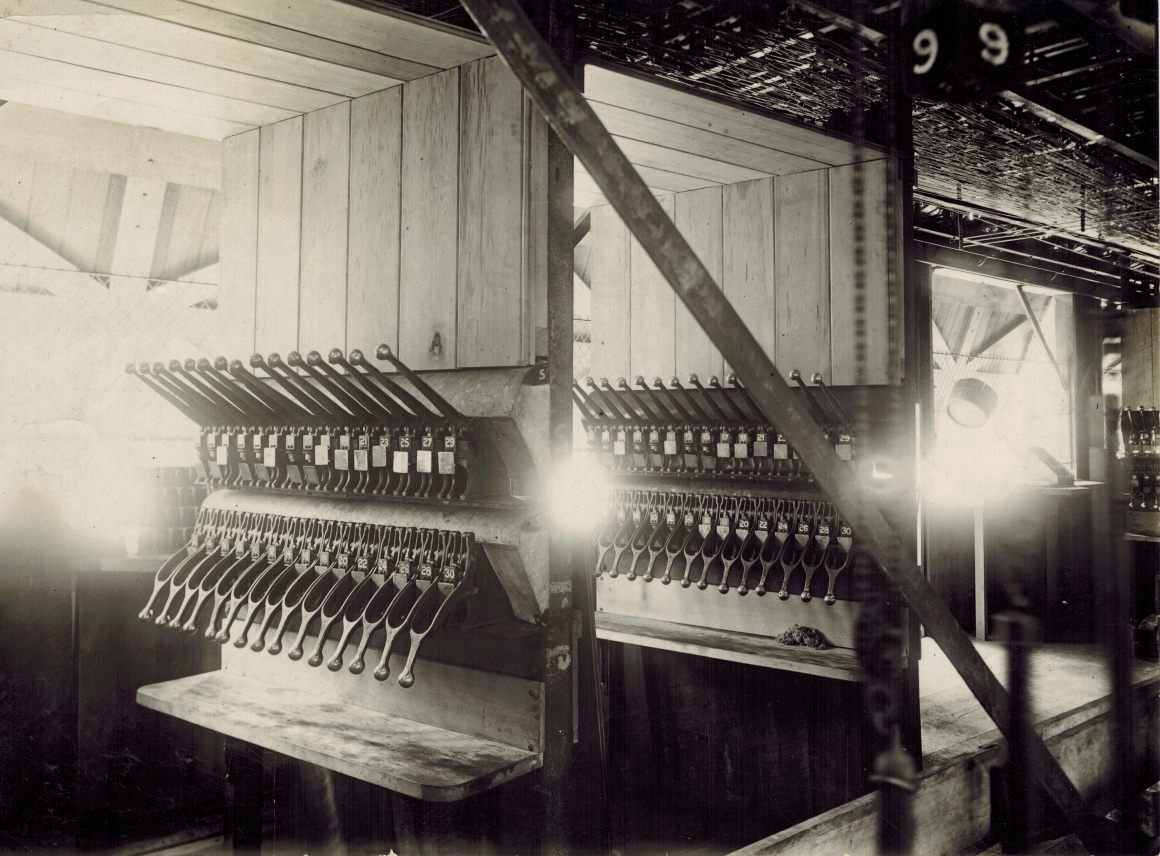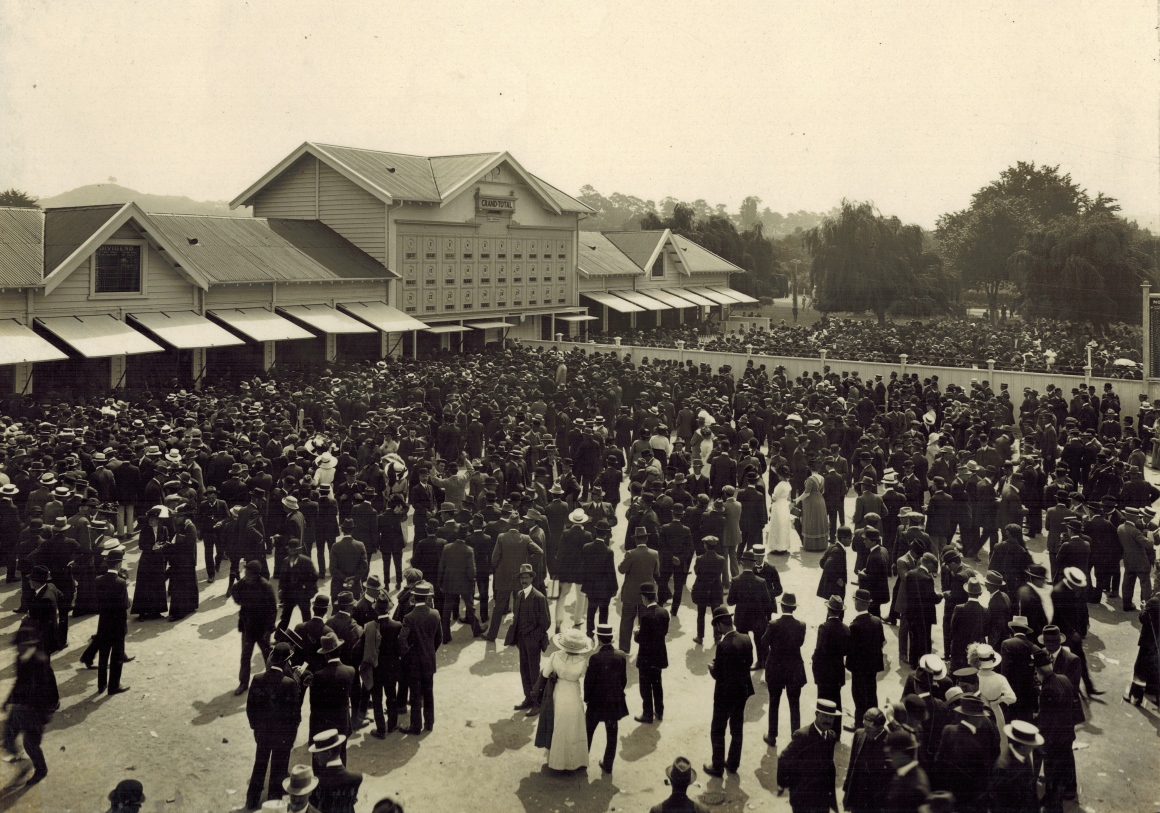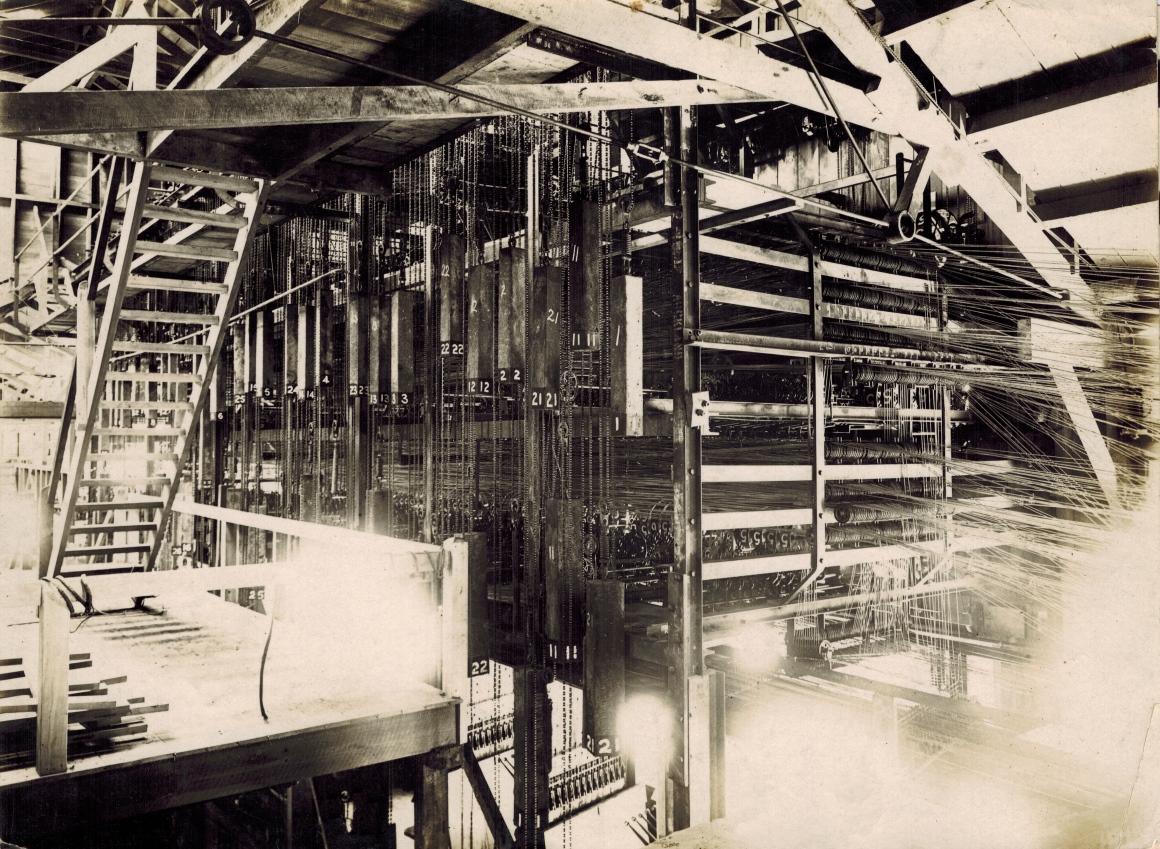This history page contains a photograph which is one of several belonging to the photo gallery pages which are part of several pages relating to the invention of the world's first automatic totalizator in 1913 and Automatic Totalisators Limited, the Australian company founded in 1917 to develop, manufacture and export these systems.
Copyright © 2014 Email - totehis@hotmail.com
Mechanical Computing the world's First Automatic Totalisator
This image shows three of the thirty selling stations of the first Julius totalisator which was installed at Ellerslie New Zealand in 1913. This system was purely mechanical. Apart from being the world's first automatic totalisator, this is a significant machine in the progress of technology and computing as it is the first real-time multi-user system. The handles at these stations are the user interface. In the following Julius Tote installation, which was also purely mechanical and was installed at Gloucester Park in Perth, these selling stations had already taken a step towards the more recognisable terminals of the computer era. The user interface was based on self contained portable TIMs (Ticket Issuing Machines.) The Gloucester Park system is covered in the following page after this one in this website, and the two pages after that present the self contained portable TIM just mentioned.

Click on the image to go back to the Photo Gallery
If you arrived from navigating the website, use the navigation bar at the bottom of this page.
The photographer's stamp on this photo reads: FARNALL ART PHOTOGRAPHER 402-420 Victoria Arcade Auckland Phone 2974
This photograph is over a century old and was 100 years old in 2013--part of a real time multi user computing system over a century ago!
The beer tap handles as they have been called, shown in the image above, were used by the sellers to register transactions and produce tickets. Each handle represents a runner in the race. As can be seen the highest numbered handle is 30, therefore this system supports up to 30 horses in a race. It also had 30 of these selling stations. Support for 30 runners can also be seen in the investment indicator in the image below in the central part of the totalisator building. There is one investment counter for each runner in a race and these counters are inside the slots in the indicator arranged in three rows of ten.
The windows from which all the light is emanating in the image above, can be seen on the ground level in the outside view of this tote house in the image below. The windows in the image above appear to be partially opened to admit some light for the photograph. The shutter on the third selling station appears to have a cylindrical object in the middle of it. Zooming in on this in a high resolution version of the image above it can be seen that this is a pail constructed in the same fashion as wooden barrels. It seems it has been jammed between the shutter and the window grille to keep the shutter partially open. In the image below these windows are fully opened to serve the punters. Whilst on the subject of the pail and the subject of zooming in, on the table at the bottom right of the window with the pale, an object can be seen extending towards the pale. This makes it look like it belongs to the pale as if it were a handle. Whilst zoomed in on the pail it was clear that this item on the bench looks like it is an angled cash tray.
The mass of cabling visible at the top right of the image above is all part of the mechanical connection cabling between the 30 selling stations and the mainframe above this level visible in the second image below.
The Referee newspaper article extract below contains the following statement: When the non-starters are known, the sections bearing numbers corresponding with them are locked throughout the totalisator. This feature is implemented through the handles in the selling stations and the locking system can be seen in the image above. Looking at the upper handles in the nearest set of handles, there are runner numbers at the base of each handle. Immediately below some of the runner numbers there are metallic plates. The runner numbers that do not seem to have corresponding plates, do actually have plates but they are pushed downwards into a lower position creating a second row of these plates. These plates are the means for disabling transactions on invalid runner numbers which are either scratchings or runner numbers in excess of the highest numbered runner in a race. The runners with their corresponding plates in the up position are disabled. It can be seen that with the lower row of runner selection handles there are similar plates near the base of the handle, however only the top part of the plate is visible when the plate is in the up position with the lower position of the plates placing them out of sight in this image. As with the top row the upper position of these plates in the second row, where the top of the plates are visible, disables the associated runner number handle. As the odd numbered runner numbers are in the top row, runners 1,3,7,9,13 and 15 are enabled. In the bottom row, which controls the even numbered runners, the plate is visible in the first runner handle meaning runner number 2 is disabled, but not visible in runner numbers 4,6,8,10,12,14 meaning these are enabled, and the plates are visible in the rest of the runners in the lower row up to 30. Putting these two pieces of information together, this selling station is configured to enable runner numbers 1,3,4,6,7,8,9,10,12,13,14 and 15. In other words this selling station is configured for one of two possible race scenarios, firstly the field size is 15 and runners 2 5 and 11 are scratched or some of the scratchings are 2 5 and 11 and one or more consecutive runners following 15 have also been scratched, in which case we do not know what the field size was to begin with. Both cases are covered by this configuration. With this arrangement for configuring valid runners in a race, every selling station in use has to be configured the same.
The Ellerslie tote house

Three of the selling stations shown in the image at the top of this page, can be seen at the bottom middle of the image below. As can be seen the mainframe section is on the first floor level with the selling stations below on the ground floor. Below the platform level at the bottom of the staircase in the image below and to the right of the platform below the weights numbered 21 11 and 22, the three different selling stations are visible. Some of the operator controlled beer tap like handles are visible on the two right hand selling stations rising upwards and to the left. Three of the knobs at the tip of the handles are visible in the left hand set of handles and five visible on the right hand set. Having mentioned the mainframe in the image below is above the selling stations, the mainframe is installed behind the indicator in the mid section of the tote house in the image above. The mainframe contains the counter wheel displays that are visible from the outside of the building through the slot like windows in the indicator. These counter wheel displays are on the opposite side of the mainframe to the side visible in the image below. Parts of some of the counter wheel displays are visible through the machinery in a high resolution version of the image below.
At the top right of the image at the top of this page, there is a number nine visible. This is the bottom of one of the dangling weights as shown in the image below. This number nine weight shown in the image at the top of this page belongs to the lower bank of weights shown in the image below. It is possible to read the 8 on the upper number 8 weight in the image below and the number nine weight can be seen through the staircase in a high resolution version of the image below, however its number is hiding behind one of the steps in the staircase.
A full sized version of the image above can be seen in the Photo Gallery of this website. To view this, click on the image at the top of this page and scroll up to the second thumbnail in the photo gallery index and select that. Similarly, a full sized version of the image below can be seen in the Photo Gallery of this website. To view this, click on the image at the top of this page and scroll up to the first thumbnail in the photo gallery index and select that.
A view above the image at the top of this page

Following is part of an article that appeared in The Referee newspaper on 17th December 1913. It is titled THE TOTALISATOR WHICH ENSURES INSTANTANEOUS REGISTRATION with a subtitle of OTHER GREAT IMPROVEMENTS--ACCEPTABLE CHRISTMAS BOX FOR DEVOTEES OF THE MACHINE. It relates to the first of the Julius Totes which was installed at Ellerslie as shown in the images above and is considered the world's first automatic totalisator.
The Citation: A TOTALISATOR THAT REGISTERS INSTANTNEOUSLY (1913, December 17). Referee (Sydney, NSW : 1886 - 1939), p. 7. Retrieved December 1, 2016, from http://nla.gov.au/nla.news-article120488565
The first paragraph describes the operation of the selling stations shown in the image above:
A brief description of the method of issuing tickets will, no doubt, be sufficient regarding the "inner workings." At each window there are two men, one of whom does nothing but receive cash and hand over tickets, which he gets from the other, having called the requirements of the investor. The ticket-issuer has in front of him a magazine about 3ft high with levers on either side up to as many as required by the club. Generally 30 would be enough, but it is a matter of no trouble to supply magazines containing more (or less). When the non-starters are known, the sections bearing numbers corresponding with them are locked throughout the totalisator, and by no means can the levers of those sections be operated or tickets issued therefrom. Then to issue tickets on any of the starters the issuer pulls the lever corresponding with the number of the horse required, and a ticket is released through a slot automatically. The ringing of the starting bell, however, operates part of the mechanism by which all these levers are locked. And it is then impossible to pull them for the issue of tickets. As showing how secure the system is, it is worth pointing out that if a man had asked for five tickets on No. 10 and the bell rang when the clerk had only pulled the lever three times, all the backer would get would be three tickets, because the clerk could not get any more for him if he wanted to. His balance of £2 would, of course, be refunded with the three tickets.
Webmaster's comment: It is interesting to read this 1913 reference in the paragraph above, to "how secure the system is." The writer would have had no concept what a huge subject security of computing systems of the future would become!
These, then, are the salient features of the "new idea," which is a wonderful mechanical contrivance by reason of its great extent, yet simple enough for operating at a small course. Electricity alone can give it the great advantage it possesses over other machines. Without that force it would not be possible--as it is on a similar machine at Auckland--for 51 tickets to be issued by all the sellers at the one moment and recorded simultaneously. This, of course, does not happen often, but it has been tested on the machine, while the same process was one of the tests employed on the model referred to above.
Webmaster's comment: With respect to the test of "51 tickets issued by all the sellers at the one moment and recorded simultaneously", yes it is a realtime multiuser system!
APPRECIATION FROM AUCKLAND
Some few months ago a machine practically the same as this was installed at Auckland, and from the first race in which it was used it was hailed with delight, by Press and public. In fact, a prominent Sydney sportsman who has only recently returned from one of several trips to New Zealand, said that the new machine had revolutionised wagering in the northern city. He stated that he found the old antipathy to the totalisator almost entirely eliminated, and expressed the opinion that nothing more satisfactory could be desired by anybody.
In addition to the one installed at Auckland, other New Zealand clubs are treating for the purchase of one, while Queensland and Western Australia may shortly have them on a couple of courses. The machine certainly looks to do what is claimed for it, and that being so we should soon be without the complaint so frequently heard nowadays that the totalisator can not thoroughly satisfy even its own devotees.
A prior segment to this Referee newspaper article extract can be seen by selecting the "Previous page" button in the Navigation Bar below.
- Thanks to the National Library of Australia Trove Digitised Newspaper archive for providing the Referee newspaper article shown in the citation above.
- Thanks to Professor Bob Doran for sending me a copy of The West Australian newspaper article which referenced and led me to find the Referee Newspaper article presented above.

Comments and suggestions welcome to
totehis@hotmail.com 
The next page is page five of five relating to the Ellerslie system.



